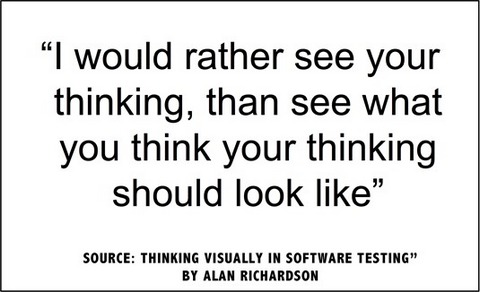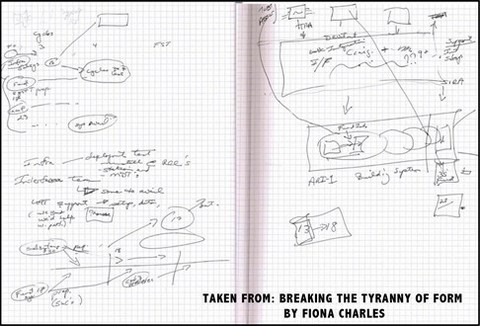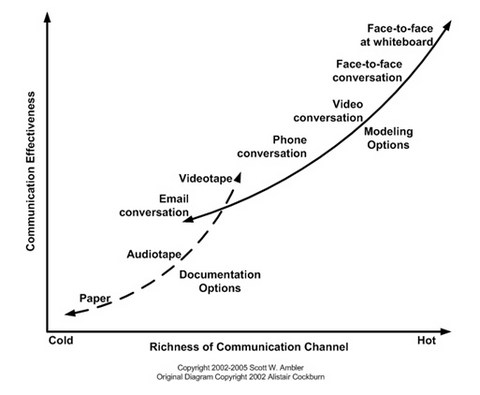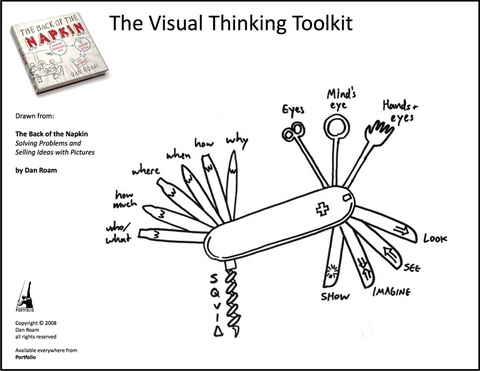This blog post was originally written as an column for www.testnewsonline.com (English) and www.testnieuws.nl (Dutch).
Did you have a chance to see the webinar “Thinking Visually in Software Testing” by Alan Richardson at the EuroStar Virtual Conference May 16th last? If not I suggest you do that now before you read this column. Also very interesting is the great blog post Fiona Charles has written about this topic with the beautiful title “Breaking the Tyranny of Form”.
Alan explains that simple techniques and tools you can make your thinking visual. It makes your thoughts visible what benefits the feedback to yourself, but also the communication of your thoughts to others. In the webinar Alan shows some simple drawings that made his thought process transparent. The webinar also shows some simple tools that can help you.
Fiona is annoyed by documents where the form is more important than the content. These documents are driving and constraining our work. She explains that templates limit thinking and creativity. In her article she shows some examples of visual representations that helped her in her work.
Text is boring and not very creative. It lets your brain run at half power, only the left part of the brain is put to work. Using images will also put the right part of your brain to work. People remember images easier. In addition, images often impress us more. A text normally needs many pages to describe what a single picture can say. The saying “a picture is worth a thousand words” is really true! A single image can transfer a complex idea fast and easy. Visualization allows us to quickly absorb large amounts of information.
Collaboration through effective communication
Visualization makes your work easier! Through visualization, communication is richer and that makes our work easier. Understanding each other is often the first step to successful collaboration. To clarify the added value of different forms of communication, I often show this picture:
This picture makes clear that communication is enriched with visualization. For who ever bought a new house, you know: graphics were the deciding factor. The plans and artist impressions gave, before only one stone was built, an impression of how the future house was going to look like. The visualization of the house to be built, informed your decision. Could text do the same?
But why do testers still produce so much text in their work? The creation of “traditional” test plans, test reports and test cases is very time consuming. And I think they do not add a lot of value. Have you ever wondered how many people actually read your test plans arising from the use of a 21-page template? And if somebody would have read it, how much useful information is in there for the reader? And what will he ultimately remember?
Mind Maps
Nowadays mind maps are very popular. I use them almost daily for various purposes: insight into situations, problem solving, summarizing, making records, creating plans, develop ideas or report status. I even created a mind map of my resume. The possibilities of mind maps are endless. The theory behind mind maps is fairly simple and making them stimulates the creative side of our brains through visualization.
On the back of a napkin
The drawing of (simple) images can be of great value. In my search for literature on creativity and visualization a few weeks ago, I walked into a book by Dan Roam called “The back of a napkin, Solving Problems and Selling Ideas with Pictures“. In this book Dan Roam describes how a simple drawing can help. I’m not a great artist and the simple drawings in this book appealed to me immediately. Ultimately it just requires drawing of simple shapes: lines, rectangles, smiles and stick figures.
His philosophy is that every problem can be solved with a simple drawing. In his book he introduces four steps of visual thinking, five questions that help focus and six ways of seeing. Try it and see if it helps you.
Inspiration
I hope these examples inspired you to try to use more visualization. Try writing a test plan with a mind map or visualize your test strategy and scope with images. Why not put your thoughts on paper using a few sketches? Don’t let the thought that you can’t draw stop you. The creative process is much more important than the final result. Furthermore, you will see that it isn’t really that bad!
Awesome examples
Finally, I want to share some great examples of visualizations, two beautiful animations. The first is Steven Johnson – Where Good Ideas Come From:
And the second is Dan Pink – Drive. The surprising truth about what motivates us:
This Dutch example by Avans Hogeschool also shows how powerful visualization can be:
Gojko Adzic uses simple but very powerful pictures in his presentations that help me understand and remember his message easy.
The last example I like to share is a blog post about visualizing strategy, concept and design which shows some good examples of visualizations and has a few interesting links at the end. Good luck!







Leave a Reply